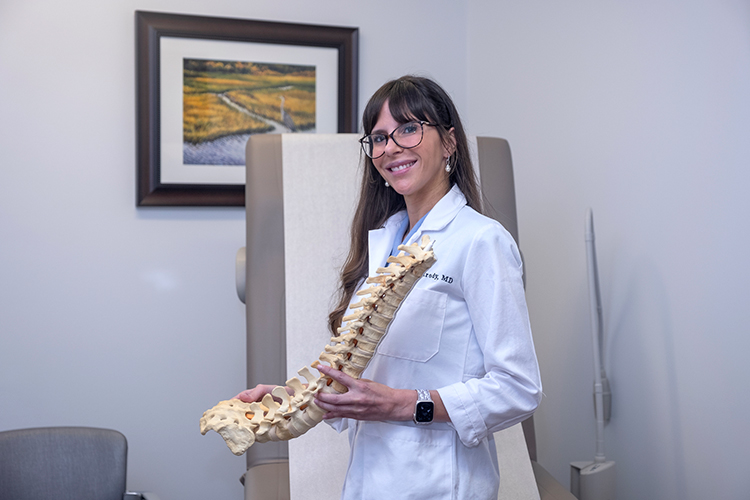Bones. Without them our bodies would just be a puddle of skin, muscle, organs and guts on the floor. The musculoskeletal system – bones, muscles, tendons – supports and shapes the body while protecting delicate internal organs like the brain, heart and lungs. Bones also contain most of our body’s calcium supply.
Unfortunately, though, as we all know, these critical structural supports tend to get weaker with age, a condition called osteoporosis, which “affects 54 million men and women in the United States over the age of 50,” according to the International Osteoporosis Foundation.
Happily, there are things that can be done to reduce bone loss and weakening.
Ivana Parody, M.D., a board-certified doctor of rheumatologic and immunologic disease Cleveland Clinic Indian River Hospital, said the best way to prevent osteoporosis is to be proactive: Eat a balanced diet rich in calcium and vitamin D. Exercise regularly. And get a bone density scan to see what condition your bones are in so that you can calibrate treatment and take appropriate precautions to protect yourself from falls or other injuries.
“All women over the age of 65 and men over the age of 70 should have a bone density scan on a DEXA machine,” Dr. Parody advised. “The screening is done with a very low-density X-ray machine to measure the bone loss in your hips and spine. We advise having it done every two to three years to help your doctor determine how quickly you are losing bone density and predict your risk of fracture.
“Osteoporosis is a condition where bones become thin and lose their strength, which can often lead to broken bones,” Dr. Parody said. “An estimated 8.9 million bones are broken each year and it doesn’t have to be a major trauma in order to have a fracture. You can break a bone just by coughing or wheezing.
“Osteoporosis literally means porous bone and women over 50 have a 1 in 2 chance of having fractures, while men over 50 have a 1 in 4 chance of having fractures” Dr. Parody continued.
“After the first fracture you are four times more likely to have a second fracture within one year.”
Osteoporosis is often called a ‘silent disease’ because most people don’t know they have it until they suffer a broken bone from a minor fall or bump. And even after breaking a bone nearly 80 percent of patients are not diagnosed and treated for osteoporosis.
“The most common bones to break due to osteoporosis at the spine, wrist and hip,” Dr. Parody revealed. “The hip is very dangerous as you may end up in the hospital with surgery and may endure more complications like blood clots and bed sores. Thirty percent of those suffering from a broken hip will die within the first year of having that hip fracture.”
The International Osteoporosis Foundation reports that hip fracture survivors often experience a loss of independence, with 40 percent unable to walk independently and 60 percent requiring assistance a year later. Eighty percent are restricted in other activities like driving and shopping.
The fracture can affect people emotionally as well as physically, reducing quality of life and causing isolation.
So how does osteoporosis develop?
From birth on, our bones grow until our mid-20s, when they reach what is called peak bone mass and are at their strongest and least likely to fracture. Throughout life, bone is constantly being renewed with new bone cells replacing old ones. But for people with osteoporosis, more bone is lost than replaced as they age away from peak bone mass and the bones become brittle and more likely to break.
“After middle age, bone reabsorbs faster than bone forms and they become more porous and weaker,” Dr. Parody continued. “Women are especially prone to getting osteoporosis, as there is a direct relationship between menopause and the development of the disease.
“In the five to seven years following menopause, there is a very high loss and women can lose 20-to-30 percent of their bone mass. The thicker bones are when a woman hits menopause, the stronger they will be and the less likely osteoporosis will set in.”
Other than age, risk factors for developing osteoporosis include having a family history of the disease, drinking more than one serving of alcohol per day for women or two for men, excessive drinking of coffee or soda, having a vitamin D deficiency, smoking, being thin or small-boned – or overweight. Certain diseases, medications and a sedentary lifestyle also can increase the risk of developing osteoporosis.
Fortunately, there are a variety of treatments for osteoporosis that have been shown to reduce the risk of hip fracture by up to 40 percent, the risk of vertebral fractures by 30-to-70 percent, and the risk of other fractures by 15-to-20 percent.
The two main types of treatment are anti-resorptive agents that reduce bone destruction while preserving bone mineral density, and anabolic agents that stimulate bone formation and increase bone mass.
“Above all, pay attention to your body,” Dr. Parody said. “If you experience back pain, get it checked out by your physician. Compression fractures occur mostly in the spine and you wouldn’t even know you had a fracture without an X-ray. If you fall from a standing position, that could be a sign of osteoporosis, so talk to your provider about your risk. You need to be your own best advocate.”
Dr. Ivana Parody received her medical degree from the Universidad Nacional de Cordoba Facultad de Ciencias Medicas in Argentina. After an internal medicine internship and residency at Mount Sinai Medical Center in Miami Beach, she completed a fellowship in rheumatology at the University of South Florida in Tampa. Her office is located in the Cleveland Clinic Indian River Health and Wellness Center, 3450 11th Court, Suite 302, Vero Beach. Call 772-569-8550 to schedule an appointment.

